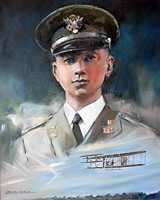Inducted in 2009
One of first trainees for military aircraft
September 16, 1883 – January 20, 1941
After attending the Pennsylvania Military Academy, he won an appointment from New York to the United States Military Academy at West Point, graduated and was assigned to the Corps of Engineers. After assisting in bridge construction, he was deployed to Cuba during the Pacification Expedition, and a year later, returned to attend the Engineer School. While at the school, he was detailed to the Signal Corps.
“Aeroplane No. 1, Heavier-than-Air Division, US Aerial Fleet” was officially accepted by the US Army on August 2, 1909. 800 pounds of bamboo, wire and cloth, and a 30 hp engine connected to propellers by bicycle chains had cost the government $30,000. Included in the contract was the requirement for the Wright brothers to train and certify two military officers as pilots. These were to be Lieutenants Lahm and Foulois; the latter, however, was dispatched to attend the International Congress of Aeronautics in Europe, and Lieutenant Frederick E. Humphreys was detailed to take his place.
Shortly after 8 am on October 26, 1909, a mechanic held a gasoline soaked rag over the engine intake while another cranked the engine into life. Wilbur Wright hurriedly ran to a nearby shed for windowsash weights to replace his weight in the passenger seat.
After a little over three hours of actual flying time, Lieutenant Humphreys became the first military student pilot to be told he was ready to “take her up on your own.” A catapult weight dropped, and plane and pilot were assisted aloft for a three minute flight.
Two more flights were made by Lieutenant Humphreys that day, the next of eight and one half minutes, and the last of twenty-four minutes. Lieutenant Lahm also soloed for three flights, and Wilbur Wright pronounced both “certified pilots.” Over the next few days the two flew practice flights together and separately, until November 5th, when they crashed the plane and American military aviation came to an abrupt and temporary end.

